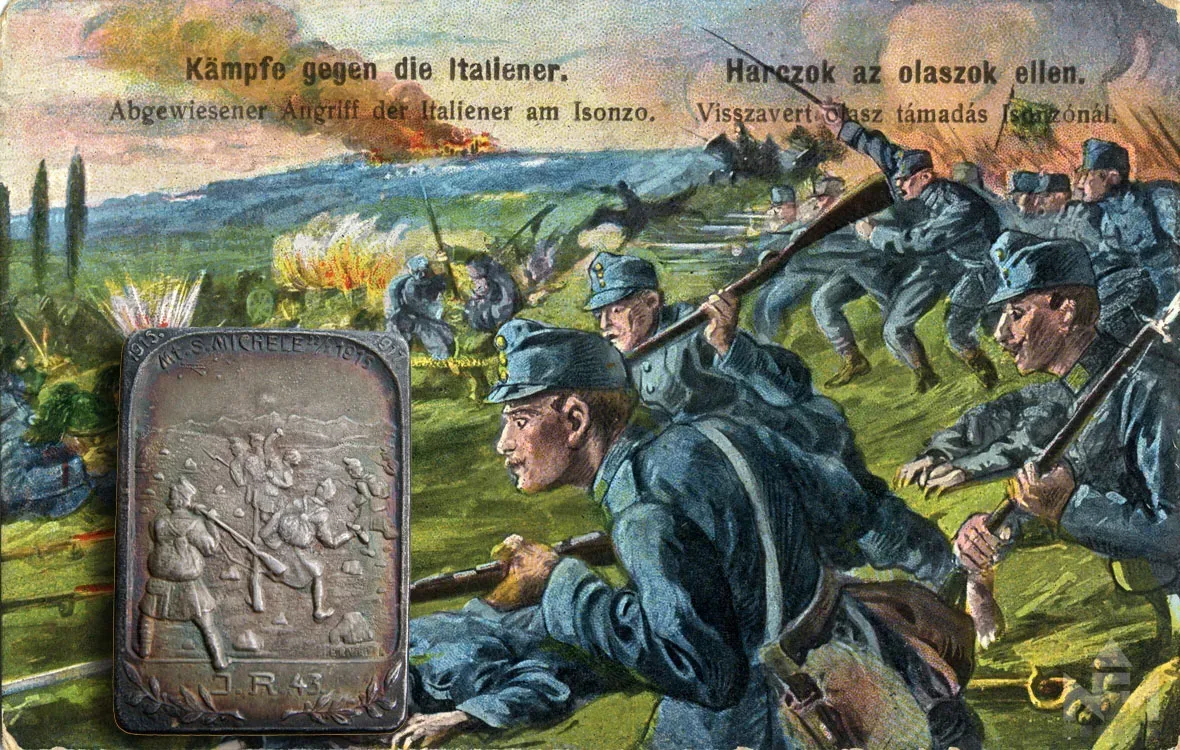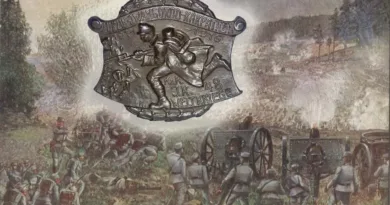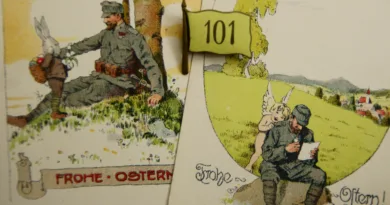October 1915
Mt San Michele October 22, 1915, 43rd Infantry Regiment. This inscription is placed around the battle scene set in the stony landscape. That’s pretty much it, we know almost everything, just nothing about the details. Mt San Michele was the most important point of defense of the Karst Plateau. Not only because it is the highest point, but also because this height is closest to the besieged town of Görz. From here you can keep the whole area under fire. So, this is a point of strategic importance. Accordingly, there were severe combats for possession in 1915-16.
I have already mentioned in connection with the 20th Division that it has made many bloody sacrifices in defense of the mountain. Another permanent division of the VII. corps was the 17th. One of the regiments of this division was the 43rd Infantry Regiment, which recruited its soldiers from the eastern part of the Banat, thus consisting mainly of personnel of Romanian nationality. The regiments took turns in the Karst positions. It could easily have been that, for example, in defense of Mt San Michele, they had to defend the Italian attacks with a united force. Something like this happened on October 22, 1915 as well.
According to official descriptions, the 3rd Battle of Isonzo lasted from October 18, 1915 to November 4, 1915. The badge therefore covers that period. By this time, the Monarchy had significantly strengthened its positions on the Karst Plateau. Recessed trenches and grenade-proof covers were built, and in front of the trenches 3-4-row barbed wire barrier system was placed. A large military camp behind the front was also established in the Segethi district, where the troops were rested and replenished after the replacement. The equipment of the troops was also improved. They received several machine guns, mortars and flamethrowers, although hand grenade supplies, according to the sources, were not yet sufficient. By this time, hand-held melee weapons, such as the spiked mace in the 20th Division, were already widely used.
The Italian attack was introduced by artillery preparations lasting three days. According to the descriptions, this fire strike virtually destroyed the trenches around Mt San MIchele. Debris from the demolished parapets filled the ditches. The big attack on the front line started on the morning of October 21st. The two corps of Italian offensive forces attacking Doberdo were 2-3 times inferior in personnel. Italian pressure in the middle of Mt San Michele pushed back the front lines of the 1st and 17th Honvéd regiments defending there. The western tip of the mountain fell into Italian hands. With the deployment of reserves, the peak was regained, but the positions below it were no longer held. In these battles, in the course of 12 hours, the 1st Honvéd infantry regiment lost half of the personnel. The regiment had to be replaced.

At dawn on October 22, 1915, the 43rd Infantry Regiment replaced the bled 1st at the summit of Mt San Michele. The fresh regiment continued to hold the peak firmly in the face of subsequent Italian attacks. On the southern slope of the mountain and in the area of the municipality of San Martino, the troops of the 17th Division could not keep the first line of defense, they were forced to retreat to the second line. On the 23rd, the Italian attacks to occupy the mountain peak were repulsed everywhere by the 43rd Regiment. One of the regiment’s battalions was deployed as a division reserve at San Martino, where they managed to stop the Italian advance in heavy fighting. Here, according to reports, the 43rds, as the last division reserve, fought alongside 3rd and 4th honvéds, 17th insurgents and 24th hunters, successfully. But the Italian attacks continued with unchanging intensity. Especially on the 28th and 29th there were fierce battles on Mt San Michele. In these battles, the VII. corps’ loss amounted to 19,000 people, which was 40% of the total staff. The Italian attacks continued between November 1 and 3, were fended off only by the deployment of non-combatant personnel (paramedics, envoys, kitchen service).
The Italian losses exceeded those of the defenders. In the 3rd Battle of Isonzo, the Italian attack did not achieve the set strategic goal, which was to occupy Görz. The minimal repression of the Monarchy’s positions, a few hundred meters, was the only visible result. So this beautiful badge commemorated the outstanding defense performance of the 43rd Regiment.




